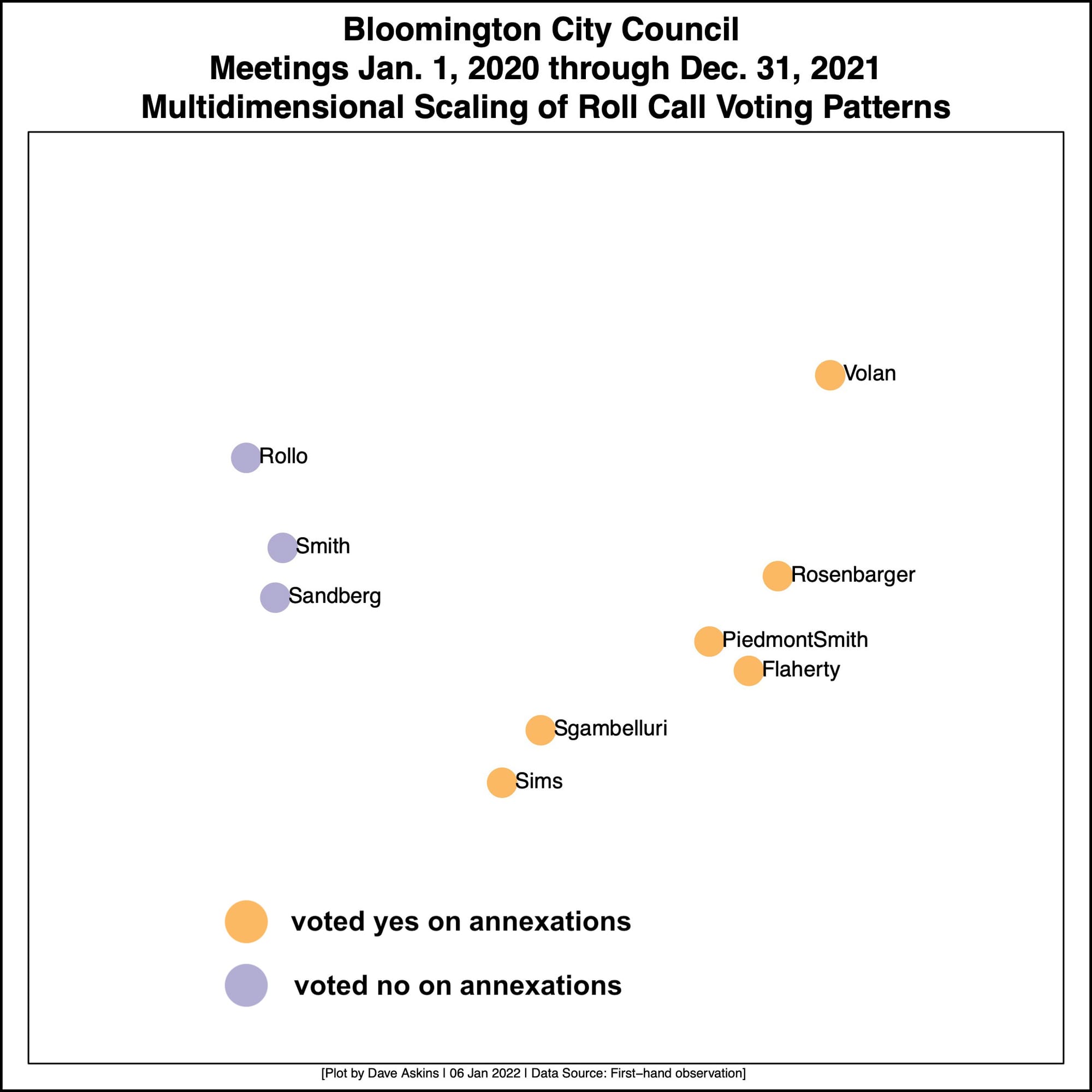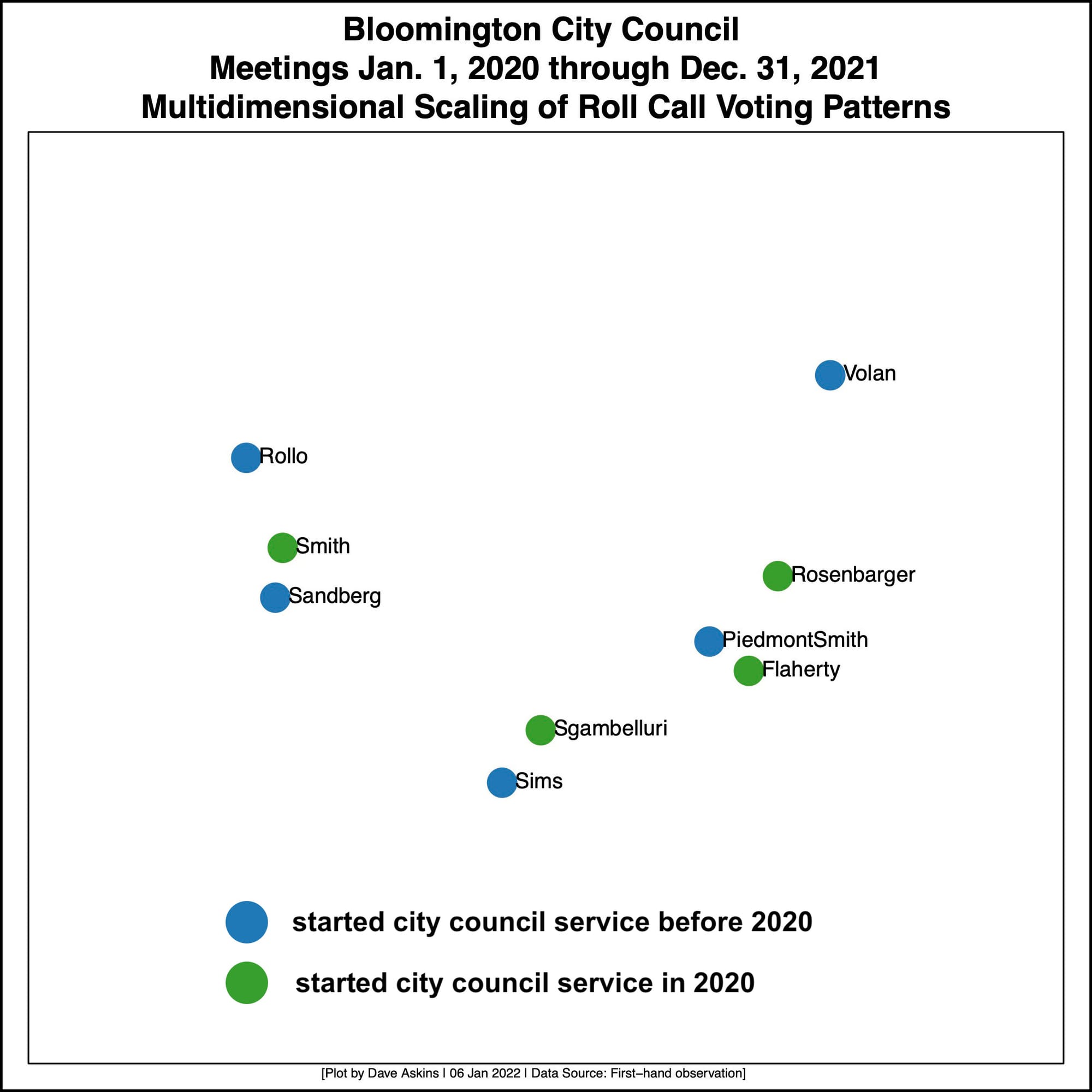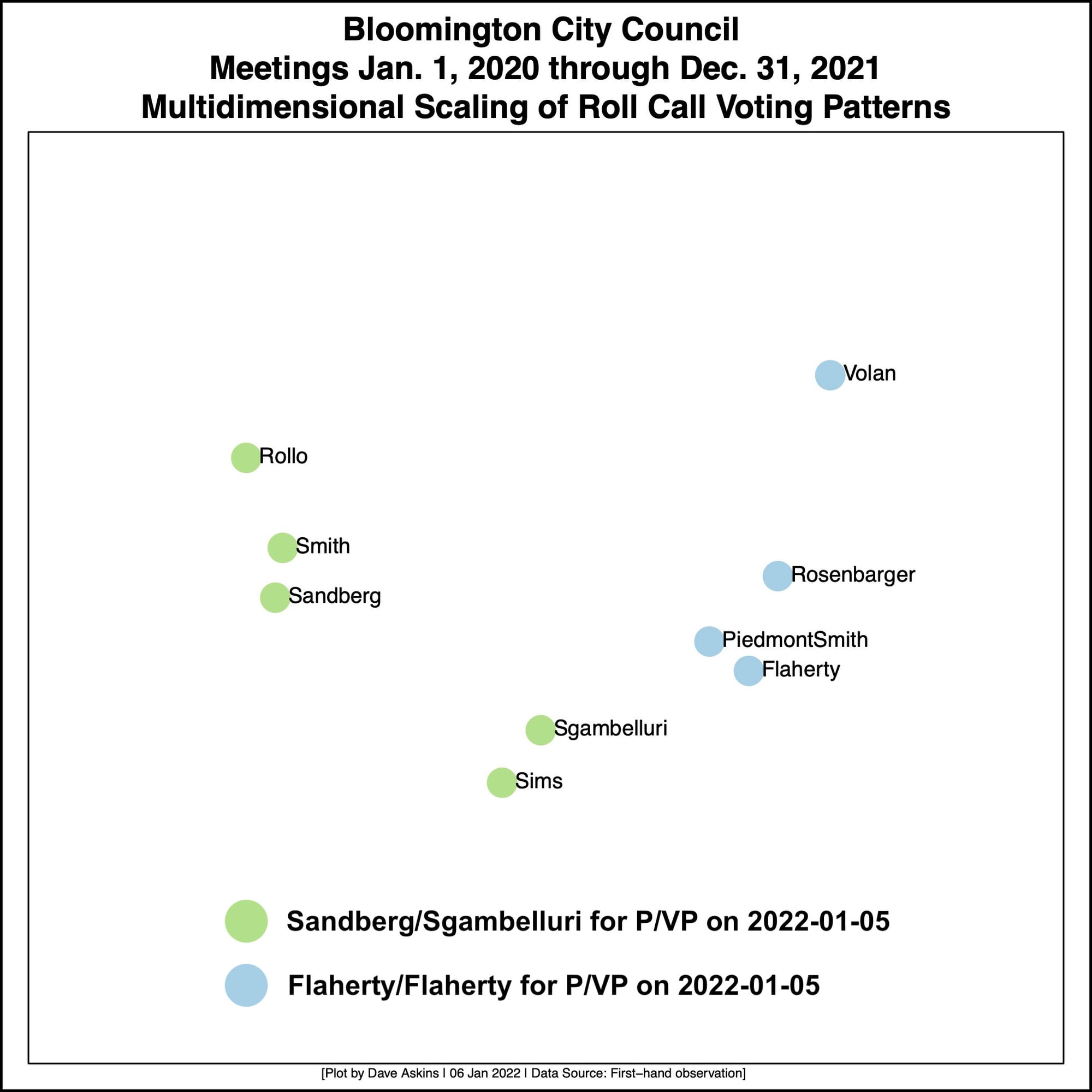Analysis: Bloomington city council splits on officer elections, members air past grievances


Last Wednesday, the annual election of Bloomington city council officers—president, vice president, and parliamentarian—took about an hour.
On a vote that was split 5–4, the council put Susan Sandberg, instead of Matt Flaherty, in the president’s chair. On a vote that was also split 5–4, the council returned Sue Sgambelluri to the vice president’s seat, instead of putting Flaherty there.
Questioning of candidates for the leadership positions was sharp, fueled by conflicts over the first two years of the current council’s four-year term.
Even though Dave Rollo was the only candidate put forward for parliamentarian, he was questioned by Flaherty in a way that alluded to an aggravated verbal exchange between the two at an early March 2021 meeting.
The 5–4 split was the same for the vote on president and vice president.
Voting for Sandberg and Sgambelluri were: Susan Sandberg, Sue Sgambelluri, Dave Rollo, Ron Smith, and Jim Sims. Voting for Flaherty both times were: Matt Flaherty, Kate Rosenbarger, Isabel Piedmont-Smith, and Steve Volan.
No one dissented on the vote for Rollo as parliamentarian.
All nine of Bloomington’s city councilmembers are Democrats.
Public versus private disagreement about council officers
Wednesday’s officer elections, which lasted about an hour, stood in marked contrast to the elections a year ago that made Sims president, Sgambelluri vice president, and Flaherty parliamentarian. On that occasion, those elected were the only councilmembers nominated, and the council wrapped up the transaction in under two minutes.
Taking even less time, about 40 seconds, were the elections of officers at the start of 2020, which was the start of a four-year term for all nine councilmembers.
It’s not the only disagreement about the council’s leadership choices in recent years, even if it’s the first time that disagreement has been aired at a public meeting.
In 2020, the council’s disagreement among its members about who should be president was hidden from public view. That’s because that year the council met in private in the backroom of Crazy Horse to hear from the candidates for president—Volan and Sims—about their visions for priorities and values that would guide the council’s work in the upcoming year.
The tally of preferences for a vision expressed in that backroom “caucus” went in favor of Volan over Sims. Some copies of email exchanges around that time were produced by the city council only after The B Square filed a formal complaint with Indiana’s public access counselor, Luke Britt, about the council’s withholding of the records.
While Indiana’s Open Door Law allows for an exception for a legitimate “caucus,” Britt’s conclusion was that the eventually produced records of city council emails, “confirm a public meeting dressed as a caucus.”
Two ‘groups’ on Bloomington city council—conceptual difference?
At Wednesday’s meeting, during debate on the question of president, councilmember Isabel Piedmont-Smith argued that because there were two clear groups on the city council, it would be fair to consider those groupings when deciding the presidency and the vice presidency of the council.
Piedmont-Smith said, “A fair and respectful way to distribute the important leadership roles of president and vice president among the two groups of councilmembers would be to have someone from the group of four be president or vice president, while someone from the group of five takes on the other role.”
The “groups” on the council to which Piedmont-Smith referred is the same breakdown as Wednesday’s split in the officer elections. Piedmont-Smith identifies herself as belonging to a group that includes Flaherty, Volan, and Rosenbarger.
In July this year, the same group of four submitted a joint memo to the mayor on their recommendations for the 2022 budget.
The grouping of four is also the same set that took part in a Jan. 5, 2020 email exchange that did not include the other five councilmembers. In the message from Piedmont-Smith to the other three, which kicked off the thread, she used the phrase “progressive caucus” in the salutation.
In her remarks on Wednesday in support of her election as council vice president, Sue Sgambelluri pegged the phrase “progressive caucus” to any even earlier time—the night in November 2019, when election results were announced.
Sgambelluri said, “It was very striking to me in November of 2019, when the election results came in, for Bloomington and Monroe County, to already start hearing chatter of the ‘progressive caucus on council’, or the ‘conservative caucus on council’.”
Sgambelluri continued, “And I don’t believe that captures the nuance of who we are as individual council members.” She added, “I think it’s very tempting, and it’s very easy, to put people in boxes. But I don’t think it serves us well. And it doesn’t show the respect that each of our colleagues deserves, to categorize them that way.”
Last Wednesday, Piedmont-Smith characterized her perception of the difference between the groups she identified on the council: “I would characterize the two groups as those who challenge the status quo, and those who usually do not.”
Two ‘groups’ on Bloomington city council—voting patterns?



Based on B Square records, the exact grouping of councilmembers in the two groups identified by Piedmont-Smith has been reflected four times in vote tallies over the last two years.
At least another five 4–4 votes could be included as consistent with the grouping. They were tallied on the night of March 3, 2021, when the council debated the ordinance that would have provided explicit protections for homeless encampments. Sims was absent on that occasion.
Based on B Square records, the first 5–4 splits on the current edition of the city council occurred almost two years ago on Feb. 5, 2020 during deliberations on the Curry Urban Properties planned unit development (PUD).
But those splits were not along the lines of Piedmont-Smith’s groupings.
In two votes on amendments to reasonable conditions for the Curry PUD, it was Rollo, Sims, Smith, and Sandberg who were on the losing side of the vote. The difference between the splits then, compared to last Wednesday, was made by Sgambelluri, who was a part of the five-vote majority made up by her, Flaherty, Rosenbarger, Volan, and Piedmont-Smith.
The next 5–4 split was recorded two weeks later, on Feb. 19, 2020—and it was again a five-vote majority that included Sgambelluri, Flaherty, Rosenbarger, Volan, and Piedmont-Smith. That vote had an impact that has rippled through the last two years of city council business: It established several standing committees for which the newly-elected Steve Volan had advocated.
A persistent source of friction over the last two years has been the answer to the question: To which committee should legislation proposed by the mayor’s administration be referred—one of the standing committees or the council’s committee-of-the-whole?
Standing committees look like an issue that some councilmembers want to revisit to start off this year. A resolution appears on the Jan. 12 meeting agenda, that would essentially return to the same set of committees that existed in 2019. The resolution is sponsored by new council president Sandberg and vice president Sgambelluri.
The groupings of councilmembers that emerge based on an analysis of all roll call votes for the last two years, without attention to the substance of the votes, could be considered consistent with the councilmembers groups identified by Piedmont-Smith.
Judged by the two-year statistical pattern, it’s also possible to identify as a two-way grouping, the 6–3 split for the city council votes on several questions about annexation, which were decided in late September. For that split, the three-member minority was made up of Sandberg, Rollo, and Smith.
Based on the purely statistical voting pattern, it’s possible to identify a three-way grouping of council members: the annexation minority of Sandberg, Rollo, and Smith; the four that submitted a joint 2022 budget memo—Piedmont-Smith, Flaherty, Volan, and Rosenbarger; and two who sit somewhere between those two groups—Sims and Sgambelluri.
Grievances aired: Council leadership meetings with administration
On Wednesday, during question time for candidates, still-acting president Jim Sims asked Sandberg and Flaherty: “If…the president is advised by our council staff, that a certain piece of legislation is not fully ready to be brought to the council, or if council staff advised you to not have a third person in a meeting…, in this case the parliamentarian, because it could violate the three-person quorum that was established by the committee structure…would you follow the advice of our council staff?”
Both Flaherty and Sandberg gave responses that could be described as incorporating the advice of their council staff, who are both attorneys. Sandberg said, “I’ve always taken the advice of our legal staff who I have great respect for, and will continue to do that.” Flaherty, who answered second, said, “I broadly share the views of my colleague, councilmember Sandberg, in that, of course, when it comes to any legal issue, our council attorneys and staff are there to advise us legally.”
What was the background to Sims’s question? In her remarks just before Sims asked the question, Piedmont-Smith had said that the parliamentarian Matt Flaherty had been “shut out of leadership meetings” over the past year, when Sims had served as president.
Based on Sims’s question, it sounds like the city council’s attorney had advised that the council should not hold regular meetings between the council’s “leadership team”—president, vice-president, and parliamentarian—and the city administration.
The B Square had raised a related question in a Jan. 7, 2021 email message to council attorney Stephen Lucas.
The Open Door Law (ODL) issue that arises in connection with regular meetings between the administration and the council’s three-member “leadership team” concerns whether that three-person group is also a de facto committee appointed by the council to handle scheduling matters with city administration. It’s known to city councilmembers, when they vote for officers, that meeting with the administration on scheduling matters has historically been a part of the function of the three, independent of their other prescribed duties.
In his response to The B Square, Lucas wrote, “I think it’s a worthwhile question to ask and explore. In order to avoid any unintended ODL issues and until further clarification can be provided, the officers may adjust how they go about discussing scheduling matters with the administration.”
Another reason that a regular gathering of three councilmembers might set the table for an ODL violation relates to “serial meetings” as defined by the ODL. The ODL prohibits “serial meetings” as a tag-team approach to circumventing the basic requirement that meetings of a governing body be noticed and accessible to the public.
A key ingredient of a “serial meeting” is that one in the series must include a gathering of at least three members. A series of gatherings between just two councilmembers, even if every councilmember were eventually included in the series, would not violate the ODL. A regular gathering of three councilmembers would potentially result in a violation of the ODL, if one attendee of the gathering talked to two other councilmembers in separate conversations.
Grievances aired: Scheduling of legislation?
Sims’s question about taking the legal advice of council staff included an angle involving the staff’s assessment of the ripeness of legislation.
That dimension of the question can be analyzed as a response to a question that Volan had asked a few minutes earlier: “Do either of you believe that this council has delegated to the president the power to refuse to schedule a first reading to a piece of legislation that was authored by a council member?”
Last year, the first effort by Matt Flaherty to place on the agenda the ordinance providing protections for homeless encampments was apparently not successful. After the 9-hour marathon meeting on the topic in March, Steve Volan indicated he would be bringing forward an ordinance that would regulate the length of council meetings. That ordinance did not appear on the council’s agenda until the fall.
Bloomington’s city council does not have a step-by-step procedure for constructing a meeting agenda, based on an adopted rule or ordinance.
The only piece of city code that seems to relate to the council president’s role in determining the council’s meeting agenda is a provision that says: “The president shall approve the agendas for regular sessions, special sessions called by the president or voted upon by the council, and committees convened to consider legislation referred to them…”
On Wednesday, neither Sandberg nor Flaherty said they think the city council president has an absolute power to prevent an item from appearing on the agenda.
Airing grievances: Questioning motives
On Wednesday, even though Dave Rollo was the only councilmember nominated for parliamentarian, he got the following question from last year’s parliamentarian, Matt Flaherty: “How would you respond or handle it as parliamentarian in the meeting, if one member questioned another member’s motives in bringing legislation?”
The background to the question includes Rollo’s question to Flaherty during the 9-hour marathon meeting in early March 2021 on the homeless encampment protections.
Rollo said to Flaherty at the March 3, 2021 meeting: “I was told by several people that at an Elm Heights meeting, you referred to this ordinance as sort of…a ‘chess game’ with the administration. And I wondered if this was correct. And is this something that you regard as a chess game?”
Rollo added, “I’m getting a bit cynical tonight about the aim of this ordinance, because it’s so ambiguous. And what is the end game that you have in mind for your chess game with the administration?”
On the factual matter, Flaherty said he hadn’t referred to his effort to put forward the ordinance as a “chess game” with the administration. Flaherty added that it’s also not how he thought of the ordinance.
Later in the March 3, 2021 meeting Flaherty reported receiving an email message during the meeting from former Bloomington city councilmember Jeff Richardson—who served as council president in 1978. Flaherty said Richardson had written that he’d attended the Elm Heights meeting, but had not heard Flaherty refer to the legislation as a “chess game.”
At the March 3, 2021 meeting, Volan analyzed Rollo’s questioning of Flaherty as a questioning of Flaherty’s motives. Volan said, “I’m more than a little offended by councilmember Rollo’s cynicism, questioning councilmember Flaherty’s motives for bringing the legislation.”
On Wednesday, Rollo responded to Flaherty’s question about how Rollo, as this year’s parliamentarian, would handle it during a meeting if one councilmember questioned another member’s motives. Rollo said, “That’s inappropriate to question the motives. We need to evaluate the matter at hand in terms of legislation, not the personal bias or politics or whatever…”
Flaherty followed up with Rollo: “And would you call out that behavior as out of order, if you were parliamentarian?” Rollo responded: “Yes.”
History of Bloomington city council officers
This will not be Susan Sandberg’s first turn of service as Bloomington’s city council president, since she was caucused into her at-large seat in 2007. She was the replacement for Chris Gaal, who resigned after he was elected county prosecutor.
Sandberg served as council president in 2008, 2011 and 2017. She also served a couple years as vice president and one year as parliamentarian.
Sgambelluri will be repeating as vice president, having been elected to that office last year in her second year of council service.
Next year will be Dave Rollo’s first year of service as parliamentarian. Previously, he has served as president three times, his most recent turn in 2019. Rollo started his council service in 2003, which makes him the longest-serving member of the current council.





Comments ()